In this article, you learn about what is combustion chamber. Also, types of combustion chambers and types of cylinder head shapes are all explained with images.
What is a Combustion Chamber?
The combustion chamber is the space enclosed between the piston head and cylinder head when the piston is at the top dead center position. It extends up to the upper compression ring of the piston. Exhaust and inlet valves open and close in the combustion chamber and the spark plug projects in it.
The design of the combustion chamber is of great importance for engine performance because the air-fuel mixing and combustion take place in it.
Read also: All About The Internal Combustion Engines (The Complete Guide)
Types of Combustion Chamber Shape
Depending upon the location of the spark plug, valves, and type of cylinder head, the combustion chambers are of the following shapes:
- Spherical shape
- I-shape
- T-shape
- F-shape
- L-shape
Spherical Shape Combustion Chambers
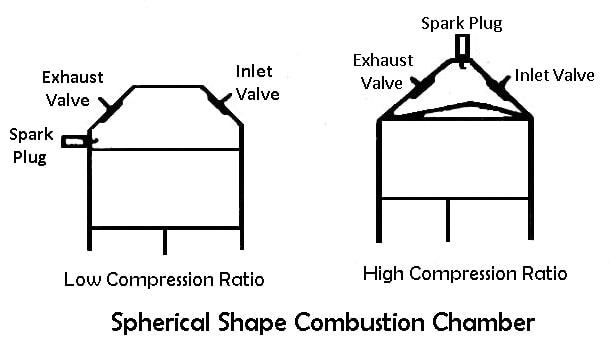
In the spherical-shaped combustion chambers, the inlet and exhaust valves are fitted in the cylinder head. A spark plug may be at the side or the top of the cylinder head.
I-Shape Combustion Chambers
In the I-shape combustion chambers, overhead valves are used. A spark plug may be fitted at the center or the side of the cylinder head.
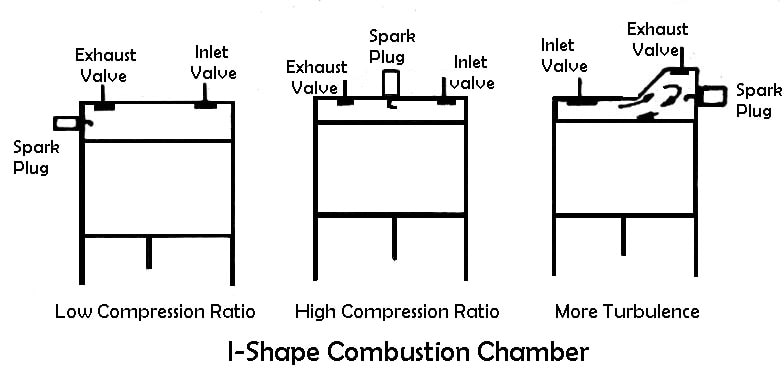
The engines having this type of combustion chamber are used in high-speed vehicles and racing cars. These engines are cheap.
T-Shape Combustion Chamber
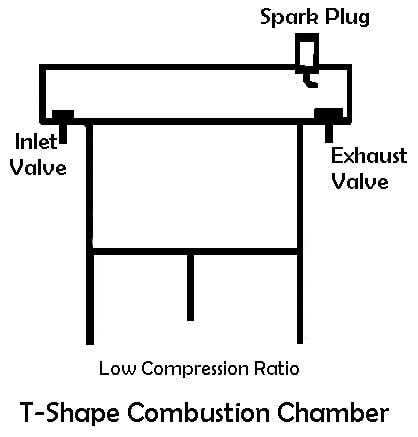
The t-shape combustion chamber is simple in construction. It projects around the cylinder head. The spark is fitted at the top and valves at the sides. The engines having such combustion chambers have good efficiency.
F-Shape Combustion Chamber
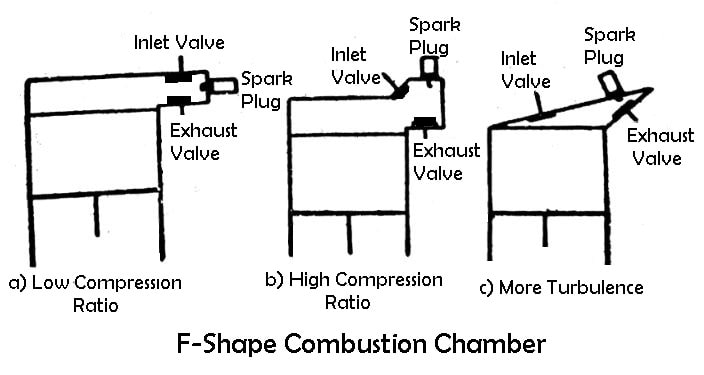
F-shape combustion chamber projects at one side of the cylinder head. The location of the spark plug and valves are shown in the figure.
L-Shape Combustion Chambers
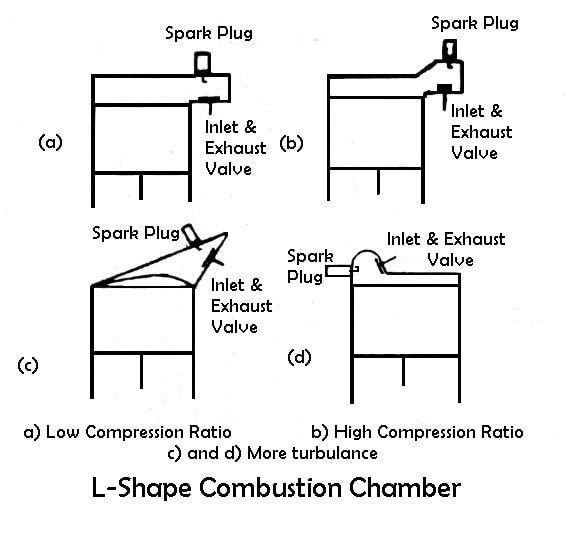
L-shaped combustion chambers used side valves. The engines having such combustion chambers are used in slow and medium-speed cars.
Read also: List of Car Engine Parts: Its Function (With Pictures)
Types of Combustion Chamber for Diesel Engine
Other types of combustion chambers for diesel engines are as follows:
- Open combustion chamber
- Pre-combustion chamber
- Swirl combustion chamber
- Squish combustion chamber
- Air cell and energy-cell
- Energy cell combustion chamber
Open Combustion Chamber
The open combustion chamber is used in medium and high-speed engines. The combustion chamber is made like a groove inside the top of the piston.
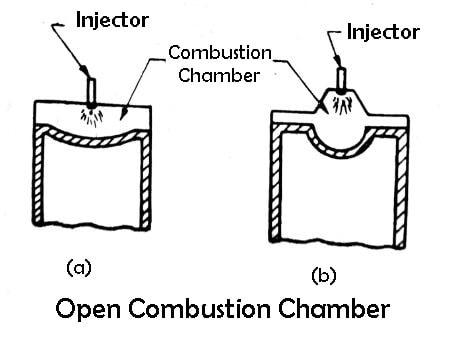
The injector is fitted at the center of the cylinder head so that it injects the fuel into the combustion chamber. The engines of Leyland buses use this type of combustion chamber.
Pre-Combustion Chamber
The pre-combustion chamber is usually used in high-speed engines. There are two combustion chambers one is the auxiliary combustion chamber and the other is the main combustion chamber. This auxiliary chamber is smaller in size than the main combustion chamber and is called the pre-combustion chamber.
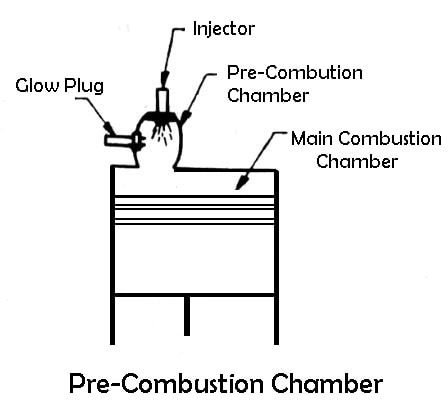
The fuel is injected in the pre-combustion chamber where is partly burned. This partly burnt fuel goes into a small hole in the main combustion chamber, where the complete combustion takes place. The turbulence created in the combustion chamber. The chamber helps to ignite the fuel completely.
Sometimes, a glow plug is fitted in the pre-combustion chamber, which is heated by electricity. It helps to ignite the combustion chamber.
Swirl Combustion Chamber
The swirl combustion chamber is also known as the turbulence combustion chamber. Swirl is a circular motion that is transferred to the incoming air during the suction stroke.
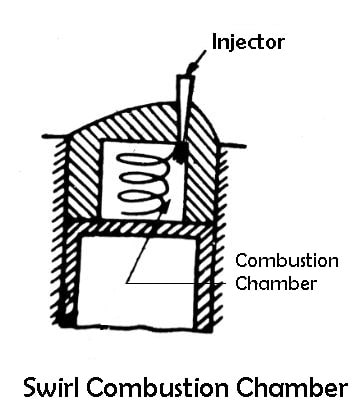
In the swirl combustion chamber, the air is given a swirl while coming into the cylinder. The fuel is injected into this swirled air so that the mixing and burning of fuel takes place completely.
Squish Combustion Chamber
Squish is a flow of air that goes from the periphery to the center of the cylinder. To get a swish combustion chamber, a groove is made inside the piston head.
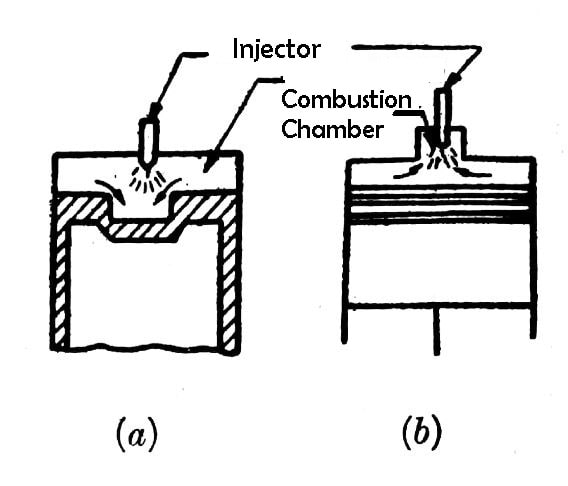
During the compression stroke when the piston moves from BDC to TDC, it squeezes the air from its periphery towards the centre. This action gives turbulence to the air. The fuel is injected at the center of the combustion chamber. Sometimes the squish combustion chamber is made inside the cylinder head.
Air Cell Combustion Chamber
The air cell is a small combustion chamber connected through the air in a narrow passage with the main combustion chamber. During the compression stroke, the air is compressed in the air cell.
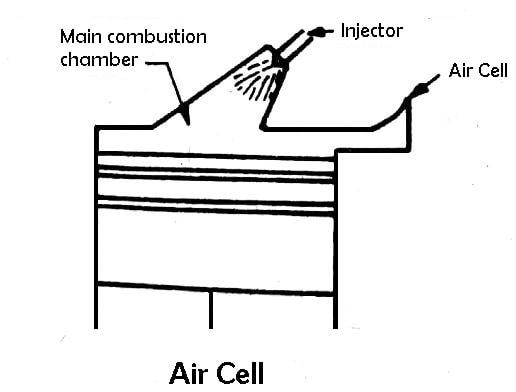
When the fuel is injected into the combustion chamber, it burns and the piston moves down. At this time the compressed hot air of the air cell comes in the main combustion chamber, creating turbulence and making the complete combustion.
Air cells are used mostly in high-speed engines. Like the pre-combustion chamber, the air cell requires a heater plug to heat the compressed air. The engines having air cells require a high compression ratio. There is more heat loss due to the increased surface of the cylinder with the air cell.
Energy Cell Combustion Chamber
The energy cell is also known as the Lanova combustion chamber. It operates on the principle of a Pre-combustion chamber and air cell. The energy cell is connected through a narrow passage with the main combustion chamber and consists of a major cell and a minor cell. These two cells are connected by a narrow opening, which can be closed by a plunger.
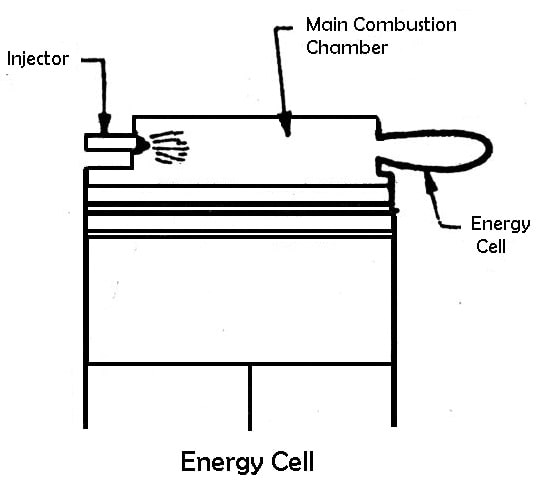
At the time of starting the engine, the narrow opening is kept closed which increases the capacity of the combustion chamber. When the engine is started, the narrow opening is opened which connects the major cell with the minor cell. When the fuel is injected into the main combustion chamber, some part of it, about 10%, goes into the energy cell also.
The combustion takes place first in the main combustion chamber and then spreads up to the energy cell, where pressure increases. As the piston moves down, the hot gases from the energy cell come into the main combustion chamber due to the pressure difference, creating turbulence and making the complete combustion.
Bowl-in piston Combustion Chamber
A high compression ratio gives high power to spark-ignition engine, hence there has been a tendency for combustion chamber shapes at T.D.C. to resemble flat discs. Also, very close tolerances have become necessary to ensure that the compression ratios of all cylinders of an engine are identical. This has led to the bowl-in piston combustion chamber, as in Rover 2,000, Ford V-four, V-six, and Jaguar V12 engines.
With this arrangement, a compact combustion chamber is obtained in which relatively close control of turbulence is possible. Also, the maintenance of close tolerances between the flat top of the piston and the flat lower face of the cylinder head is not too difficult surfaces are easy to machine all over.
The top surface of the piston is recessed to accommodate the valve faces. The spark plug is as close as practicable to the center to obtain a uniform spread of the combustion flame. The rate of heat transfer to the piston is greater than with more conventional designs.
That’s it, thanks for reading. If you have any questions or doubts about “types of combustion chamber” tell us in the comments. If you like this article then please share it.
Want free PDFs direct to your inbox? Then subscribe to our newsletter.
Download PDF of this article:
Read Next:
Where is the pdf of this?
I have updated the article with the PDF file, now you can download it.